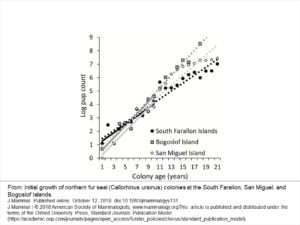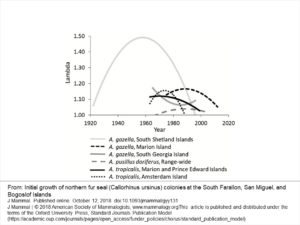Understanding the colonization or recolonization of breeding sites used by colonially breeding animals is fundamental to metapopulation theory and has practical applications in conservation biology. Historically, pinniped species (seals and sea lions) were heavily exploited worldwide, resulting in some breeding colonies becoming extirpated. As populations recover, some abandoned sites may be recolonized or new sites can be colonized.
The northern fur seal (Callorhinus ursinus) is a pelagic-feeding, polygynously breeding otariid (an eared seal with hind limbs that can be pulled under the body and used as legs on land like a sea lion), with an expansive range across the North Pacific Ocean and Bering Sea. The total northern fur seal population may have numbered 2–3 million when the first breeding island was discovered in 1742, but during more than 2 centuries of commercial exploitation for their fur under various harvest regulations, the northern fur seal population fell and rose repeatedly. Commercial and experimental harvests ended in 1984, but the global population has been in overall long-term decline since the 1950s. The current world population of approximately 1.29 million animals now breeds at 7 main sites.
In a paper published this week in Journal of Mammalogy, we analyzed aerial and ground survey data on pup counts from 3 islands (South Farallon, San Miguel, and Bogoslof) (re)colonized by northern fur seals using classical and Bayesian state-space modeling approaches to describe population growth rates during their initial 21 years, with particular focus on the South Farallon Islands. We also used information from tagged animals that immigrated to the South Farallon Islands from San Miguel Island to describe the age and sex structure of the founding recolonizers of the South Farallon Islands. We found the 3 colonies had different annual population growth rates (South Farallon = 34%, San Miguel = 45%, Bogoslof = 59%), but all were growing at rates among the fastest observed for fur seals worldwide. Immigrants from San Miguel to the South Farallon Islands were younger and female-biased relative to the tagged population at San Miguel Island.
Northern fur seals rarely colonize new sites, or recolonize abandoned breeding sites. Of 46 known breeding colonies on North Pacific and Bering Sea islands, 18 were permanently extirpated since 1742 with only 2 recolonized, and 2 new colonies formed. Likewise, abandoned or new islands are rarely (re)colonized. Northern fur seals were extirpated from the South Farallon Islands by sealers during the 1800s, but fur seals recolonized, with the first observed birth of a pup in 1996. Bogoslof Island arose from volcanic activity in 1796 and was colonized by northern fur seals in 1980. San Miguel Island was observed to be recolonized in 1968, after a 100- to 500-year period of absence of fur seals. These (re)colonization events are few in relation to the hundreds of similar islands available for (re)colonization across the North Pacific and Bering Sea.
We also examined the evidence for the generality of Roux’s (1987) description of fur seal population recovery using a literature review of published fur seal population growth rates. Population recovery is a continuous phenomenon, but Roux (1987) identified 4 phases in the recovery of fur seal populations defined by changes in population growth rate, spatial distribution, and density: 1) “survival” from the cessation of exploitation to the initiation of breeding; 2) “establishment,” when breeding is restricted to a few founding colonies; 3) “recolonization,” when numbers increase and new or renewed colonies arise rapidly; and 4) “maturity,” indicated by a decline in the rate of increase due to density-dependent factors.The general framework described by Roux was an effective description of observed fur seal population recovery. Our results inform our understanding of the initiation and growth of pinniped breeding colonies.
Derek E Lee, Ryan W Berger, James R Tietz, Pete Warzybok, Russell W Bradley, Anthony J Orr, Rodney G Towell, Jaime Jahncke; Initial growth of northern fur seal (Callorhinus ursinus) colonies at the South Farallon, San Miguel, and Bogoslof Islands, Journal of Mammalogy, , gyy131, https://doi.org/10.1093/jmammal/gyy131



